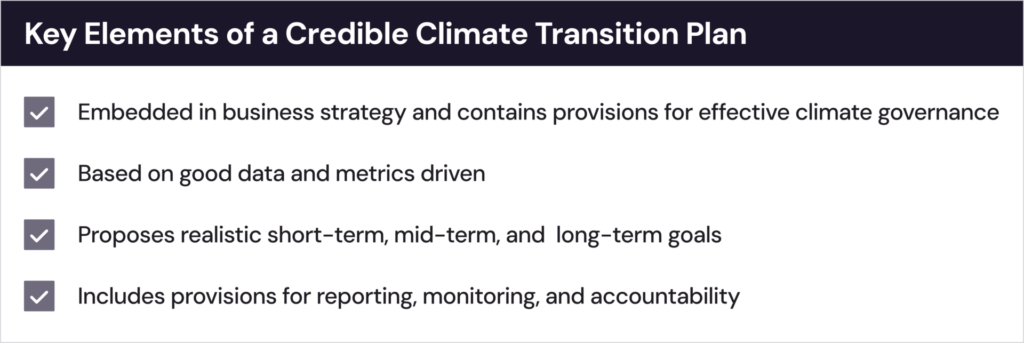As investors and consumers turn their attention to corporate climate risk, it’s no longer enough for companies to simply announce a net zero target and call it a day.
These days, companies of all sizes need robust action plans to support their public climate commitments. These plans are called climate transition plans or climate action transition plans, and depending on which regulations, frameworks, or standards you’re reporting to, the requirements for what constitutes a transition plan can differ. But there are key universal elements that all climate transition plans need in order to be considered credible and effective.
This is particularly important because stakeholders — investors in particular — are becoming more sophisticated in their ability to determine whether companies are serious about climate risk, or whether they are simply greenwashing to appease stakeholders in the short term.
Based on guidance from major frameworks and standards, we’ve identified four key elements to a credible and effective corporate climate transition plan.

Examples of corporate climate transition plans
It’s best practice to disclose corporate climate transition plans publicly, but not all companies do this — yet. Here are some publicly disclosed climate transition action plans from some of the world’s most recognizable brands. Not all of these follow best practice guidelines, but they can nonetheless be used as a source of inspiration.
FMCG industry climate transition plans
Unilever’s 2021 Climate Action Transition Plan
P&G’s 2021 Climate Action Transition Plan 2021
Colgate-Palmolive’s 2023 Climate Transition & Net Zero Action Plan
Auto industry climate transition plans
Mercedes Benz incorporates its climate transition plan into its 2021 Sustainability Report
Retail & apparel industry climate transition plans
The key parts of Nike’s climate plan are outlined in its 2021 Impact Report
Puma’s 2023 Climate Transition Plan
Tech industry climate transition plans
Google’s interactive sustainability webpage offers insights into their net zero journey
Lenovo’s 2023 Climate Transition Plan
What is a climate transition plan?
A climate transition plan details how a company plans to achieve its climate targets, including how its assets, operations, and business models will be transformed so they align with a low-carbon economy. Transition plans act as roadmaps for a company’s net-zero goals. They don’t just stipulate climate targets (net zero by 2050, for example) — they outline how these targets will be achieved in the short, medium, and long term.
Transition plans may or may not include a company’s plans to adapt to climate change. Some frameworks, such as the one produced by the Transition Plan Taskforce (TPT), contemplate adaptation efforts. Other frameworks — such as the Task Force on Climate-related Financial Disclosures (TCFD), the reporting framework that forms the basis of many climate reporting regulations — separates transition plans from adaptation activities.
Why do you need a climate transition plan?
The most pressing reason for companies to develop a transition plan is simple: climate risk is business risk. Without a transition plan, your business is more vulnerable to physical and transition climate-related risks, such as regulatory changes, market shifts, and extreme weather.
Transition plans are also critical assets for communications and stakeholder relationships. Increasingly, investors are demanding rigorous climate risk management, governments are asking for more in the way of climate disclosures, and stakeholders — including clients, counterparties, and employees — want to know that your company will survive in a changing climate. Transition plans demonstrate business model resilience in a transitioning economy. They show your stakeholders that you’re prepared for the road ahead and are mitigating and adapting to physical and transition climate risks as necessary.
Transition plans are also important for complying with relevant climate disclosure obligations, like the US Securities and Exchange Commission’s (SEC) proposed climate disclosure rule and the ISSB’s climate disclosure standard. Both these and other requirements ask organizations to develop transition plans to ensure that their climate targets are substantiated with reasonable strategies.
What makes a transition plan effective and credible?
It’s possible to understand what a transition plan is, feel the need to develop one, and still fail to develop a credible climate transition plan.
Not all transition plans are created equal. Your company’s plan must follow particular principles and contain certain key elements to make it credible and effective at guiding your organization through its climate journey. The good news is that there is plenty of guidance to help those who have been tasked with developing a credible transition plan. The bad news is that there is lots of guidance, which could be difficult to decipher and comb through. That’s why Manifest Climate has created a guide that reflects key features of a credible transition plan. Our manual also outlines seven steps for developing a credible transition plan, which are intended to help you accelerate your climate strategy and ambition.
1. Climate transition plans should be embedded in business strategy and contain ambition for more effective climate governance
It is impossible to develop a credible transition plan and to execute on it without embedding climate-related actions and targets into your company’s business strategy.
Without executive and stakeholder buy-in, you won’t get anywhere. And without eliminating ‘say-do’ gaps, a company exposes itself to stakeholder criticism. For example, a company that claims to be on a net-zero pathway, and still lobbies for the expansion of fossil fuels, reveals both a failure of executive buy-in and a lack of governance safeguards. This is a high-risk approach and archetypal failure.
Your plan must also include adequate resource allocation to make short- and long-term initiatives feasible. And to make things personal, companies should put the proper governance mechanisms — such as climate-linked pay — in place to incentivize behavior change. One effective motivator is offering climate-related financial incentives. These incentives should be significant enough to drive change and may need to extend beyond the C-suite.
It’s crucial that your entire company is bought into, and aligned with, your transition plan, and that it has the resources necessary to implement it.
2. Climate transition plans must be metrics-driven and based on good data
Transition plans should start with establishing a baseline. This involves not just examining your company’s emissions, but also assessing climate risk and opportunity, identifying decarbonization levers, and analyzing how these factors are connected.
Strong baselines are grounded in robust accounting for present carbon-emitting activities and numerical targets for the future. Transition plans should be time-bound and quantifiable — including numerical key performance indicators (KPIs) to be measured within specified timeframes.
Numerical targets set for multiple timeframes are what differentiate credible climate transition plans from other documents like impact reports or sustainability updates. While the latter publications may use vague statements and big picture vision messaging (‘climate neutral by 2040’; ‘contributing to a better world’), credible climate transition plans include measurable targets and back these up with feasible initiatives for achieving them. Climate initiatives should also be consistent with your other business activities. For example, it would be ineffective to earmark a dollar figure to spend on climate action, while also putting significant funds toward maladaptive climate practices.
3. Climate transition plans must propose realistic short-term, mid-term, and long-term goals
Although transition plans are built around long-term net-zero goals, an organization’s primary focus should be on realistic, achievable short- and medium-term initiatives that will help a company reach its climate targets. A transition plan is not simply a net-zero target. The best plans define targets and detail the action steps that are needed to get there across multiple time horizons.
4. Climate transition plans must include provisions for reporting, monitoring, and accountability
Transition plans should clearly state how a company plans to report on and review its progress toward climate goals. This makes the transition plan a dynamic roadmap that can evolve with a company. Publicly disclosing a company’s transition plan promotes accountability, as it keeps stakeholders informed about the planned actions, thereby increasing the chances of the company following through on its commitments.
Credible transition plans are flexible and responsive. They should include provisions for regular reviews and updates, as well as explain how stakeholder feedback will be aggregated and used for these updates.
Part of this flexibility and responsiveness is to ensure that your transition plan fulfills the requirements of the standards or frameworks that you currently report against or may be mandated to report against in the future. Standards and frameworks on transition plans continue to mature, and it’s important to stay informed about their expectations as they evolve over time.
Working on your climate transition plan? Manifest Climate can help.
Manifest Climate is a climate framework and disclosure management solution that helps companies supercharge their climate strategies and climate transition plans. Our platform is the world’s best at assessing climate disclosures. We help to highlight your climate disclosure and management gaps across multiple standards and frameworks and provide data-driven recommendations for improvement. Our technology also helps your team reduce time spent on manual research by 75%.

